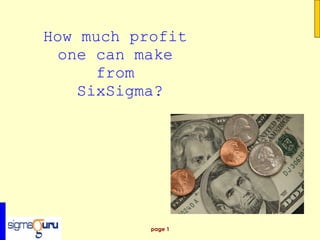
Profit from six sigma
- 1. How much profit one can make from SixSigma?
- 2. Let us consider example of – Our company making steel sheets for various applications. Thickness specified is 1000 microns with a tolerance of +/- 100 microns. (1 mm +/- 0.1 mm)
- 3. We will look at thickness of each sheet manufactured and sold. If thickness is equal to target or 1mm, loss is zero. However, Each sheet not measuring 1 mm will result in some loss to the society.
- 4. Higher thickness will mean loss to the company as more material is being given away; and lower thickness will mean loss to the customer who is getting lower weight and hence lower life and lower strength of the product. Now how to determine this loss in $? Let us take help from Taguchi.
- 5. Taguchi Loss function (TLF) says loss to the society is proportional to the square of the deviation from target. We must know loss at some known deviation to find out loss at each deviation by using TLF.
- 6. We will find this loss conveniently by assuming that A - when deviation is equal to the tolerance, customer will not buy the product and B- Cost / loss to the company will be equal to the selling price of the product.
- 7. Let us try to find out what is the cost to the organization arising out of all deviations. We will simplify our calculations by considering only one process and one parameter. (Typically, we can assume, an organization has as many processes as number of people )
- 8. In our case if every sheet is made with thickness of 0.9 or 1.1 mm, the loss to the company will be equal to the turnover of the company. Using this information we can find the value of “ k ” in the equation, which in turn will help us find loss for every sheet.
- 10. Case 1 Company process working at 3 sigma level Organisation at 3 sigmalevel 6 sigmalevel Tol / process sigma 3 6 Loss in terms of turnover 1/9 =0.111 1/36 = 0.0277 Rounded off to % 11 3 Gain by moving from 3 to 6 sigmalevel in % 8
- 11. Case 2 Company process working at 2 sigma level Organisation at 2 sigmalevel 6 sigmalevel Tol / process sigma 2 6 Loss in terms of turnover 1/4 =0.25 1/36 = 0.0277 Rounded off to % 25 3 Gain by moving from 2 to 6 sigmalevel in % 22
- 12. In reality as most of the organizations have a few processes approaching 3 sigmalevel but many at or around 2 sigmalevel, the gain will be between the 2 values, between 8 and 22% of turnover. And once you start using Six Sigma / DOE tools for continuous improvement, one can achieve gains of 3 to 5 % turnover year after year…. Surely a case for adopting SixSigma in your company!
- 13. Ready to start? Get in touch with SigmaGuru sigmaguru @gmail.com bapat@ sigmaguru .com +91 94235 07631 www. sigmaguru .com
